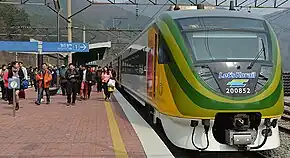| O-Train | |
|---|---|
 | |
| Overview | |
| Service type | Regional rail |
| Status | Active |
| Locale | South Korea |
| Predecessor | Circular Snow Flower Train |
| First service | April 12, 2013 |
| Last service | February 2, 2020 |
| Successor | East sea & Santa village Train |
| Current operator(s) | Korail |
| Route | |
| Termini | Seoul Station |
| Stops | 17 |
| Line(s) used | Gyeongbu Line Gyeongwon Line Jungang Line Taebaek Line Yeongdong Line |
| On-board services | |
| Seating arrangements | Car No.1: Eco seats (56 seats): Two-person seats / four-person seats / free viewing seats / etc. Car No. 2: Reserved seats for people with disabilities, café room (37 seats): two-person seats / four-person seats / one-person seat / café room, table seats Car No.3: Family seats (56 seats) – Family seats / couple room / family room / etc. Car No.4: Eco seats (56) – Two-person seats / four-person seats / free viewing seats |
| Catering facilities | On-board café |
| Technical | |
| Track gauge | 1,435 mm (4 ft 8+1⁄2 in) standard gauge |
O-Train (a.k.a. Jungbu Naeryuk Circular Train Korean: 중부내륙순환열차) was a South Korean sightseeing train operated by Korail. The train began operations in 2013 and transports tourists from Seoul, in a circular route, through South Korea's central inland region and back to Seoul.[1]
Overview
The train began operations on April 12, 2013, and is a shuttle train which loops around attractions in the central inland region of Korea, with stops, including Taebaeksan Mountain in Gangwon-do, Yeongju in Gyeongsangbuk-do, and Jecheon in Chungcheongbuk-do.[1][2] It follows the same route as the older Circular Snow Flower Train (Hangul: 환상선 눈꽃순환열차).[3]
The "O" name refers to the train's circular route, and "One", as the three provinces it travels through.[1] The train has four cars,[4][5] observatory rooms, and sightseeing monitors,[6] and departs from Seoul Station, Cheonan station, and Osong station daily.[7][8] One of the stops is at Chujeon station in Gangwon-do, located at an altitude of 855 meters, the highest altitude for any train stop in Korea, for sightseeing and photos.[2]
During its last season of operation the O-Train was rerouted to run out and back from Seoul to Cheoram via Buncheon eliminating the loop by removing its run along the Taebaek Line.[9]
A sister Korail train, the V-Train, opened on the same day, and travels through the mountainous areas of the provinces of Gangwon-do and Gyeongsangbuk-do.[5] O-Train passengers can transfer to the V-train at Cheoram, Seungbu and Buncheon stations.[8]
_11.JPG.webp)
The train's opening increased tourist interest in Gangwon's coal mining history.[10] Buncheon station in Gyeongsangbuk-do, where a coal line once ran, showed increased visits in 2013, from both the O-Train and V-Trains, from approximately 10 passengers a day to 1000.[11]
Operations
- Started running: April 12, 2013
- Ceased operating: August 19, 2020 (succeeded by the Donghae Santa Train)[9]
- Stations en route to and from "circle": Seoul Station - Cheongnyangni station - Suwon station - Cheonan station - Osong station[7][12]
- Stations on "circle" route: Jecheon station - Wonju station - Yeongwol station - Mindungsan station– Gohan station– Chujeon - Taebaek station - Cheoram station - Seungbu station - Buncheon station - Chunyang station – Bonghwa station – Yeongju station - Punggi station - Danyang station
- Approximate travel time: 5 hours.
References
- 1 2 3 Choi, In-jeong (April 19, 2013). "Traveling down memory lane". The Korea Herald. Retrieved February 25, 2015.
- 1 2 Sohn, Ji-ae (April 1, 2013). "New trains to enrich your journey". Korea.net. Retrieved February 26, 2015.
- ↑ Park, Joon Gyu (March 22, 2013). [LET´s/조성하의 철도 힐링투어]<1>백두대간 협곡열차 (in Korean). The Dong-a Ilbo. Retrieved February 26, 2015.
- ↑ Herman, Steve (May 13, 2013). "S. Korea's Newest Trains Take Tracks Less Traveled". Voice of America. Archived from the original on February 27, 2015. Retrieved February 25, 2015.
- 1 2 "Exploring South Korea via train". Manila Bulletin. November 3, 2013. Retrieved February 25, 2015.
- ↑ Mohn, Tanya (May 2, 2013). "Riding the Rail, Countryside". The New York Times. Retrieved February 25, 2015.
- 1 2 "KORAIL's mountain trains depart from Suwon, Cheonan and Osong". The Korea Herald. May 16, 2013. Retrieved February 25, 2015.
- 1 2 Limb, Jae-un (May 16, 2013). "O-train, V-train lead to hidden inland wonders". Korea.net. Retrieved February 25, 2015.
- 1 2 "CANCELLED | O-Train tourist train from Seoul to Cheoram | TrainReview". trainreview.com. Retrieved 2020-10-27.
- ↑ Lee, In-Mo (April 14, 2014). 강원 태백시 철암동 방문객 북적… 협곡열차-탄광역사촌 관심 늘어 (in Korean). The Dong-a Ilbo. Retrieved February 26, 2015.
- ↑ Briginshaw, David (February 4, 2014). "Korail hails new tourist services". International Railway Journal. Retrieved February 26, 2015.
- ↑ "KORAIL mountain train tickets on sale". The Korea Herald. April 5, 2013. Retrieved February 25, 2015.
External links
- O-Train at Korail (in Korean)